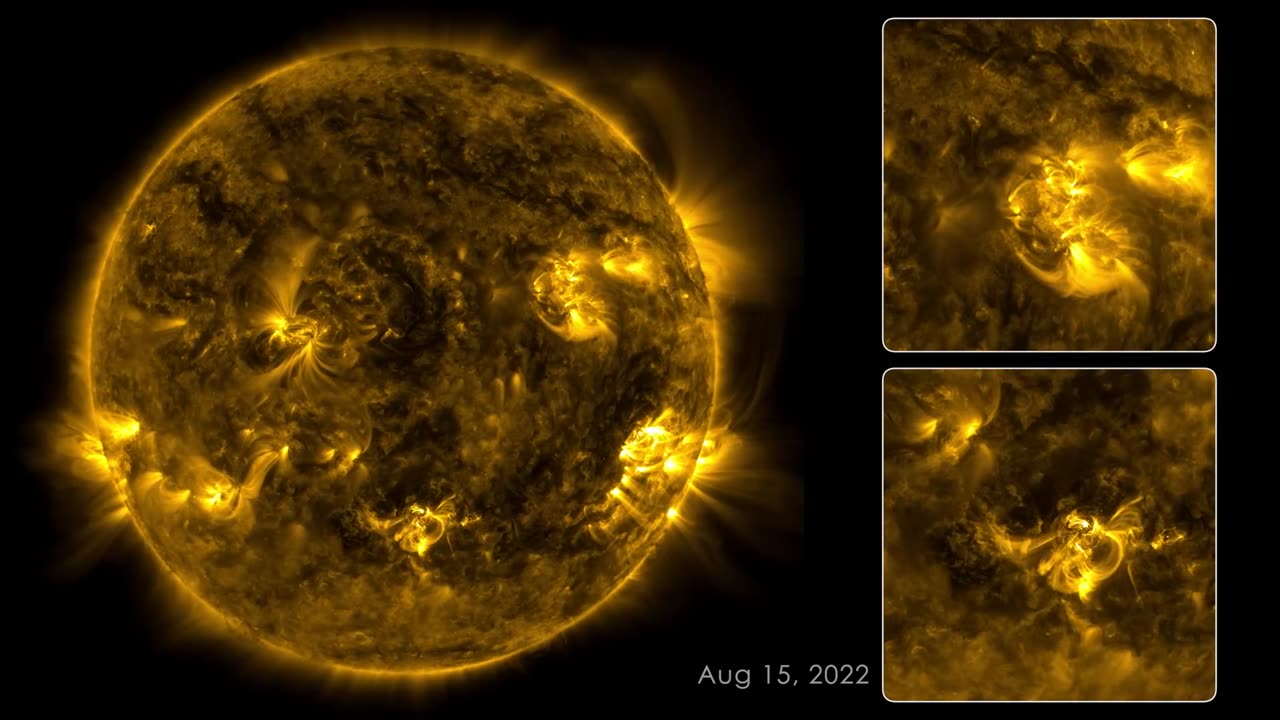Premium Only Content

133 Day's On The Sun
133 Days on the Sun
This video chronicles solar activity from Aug. 12 to Dec. 22, 2022, as captured by NASA’s Solar Dynamics Observatory (SDO). From its orbit in space around Earth, SDO has steadily imaged the Sun in 4K x 4K resolution for nearly 13 years. This information has enabled countless new discoveries about the workings of our closest star and how it influences the solar system.
With a triad of instruments, SDO captures an image of the Sun every 0.75 seconds. The Atmospheric Imaging Assembly (AIA) instrument alone captures images every 12 seconds at 10 different wavelengths of light. This 133-day time lapse showcases photos taken at a wavelength of 17.1 nanometers, which is an extreme-ultraviolet wavelength that shows the Sun’s outermost atmospheric layer: the corona. Compiling images taken 108 seconds apart, the movie condenses 133 days, or about four months, of solar observations into 59 minutes. The video shows bright active regions passing across the face of the Sun as it rotates. The Sun rotates approximately once every 27 days. The loops extending above the bright regions are magnetic fields that have trapped hot, glowing plasma. These bright regions are also the source of solar flares, which appear as bright flashes as magnetic fields snap together in a process called magnetic reconnection.
While SDO has kept an unblinking eye pointed toward the Sun, there have been a few moments it missed. Some of the dark frames in the video are caused by Earth or the Moon eclipsing SDO as they pass between the spacecraft and the Sun. Other blackouts are caused by instrumentation being down or data errors. SDO transmits 1.4 terabytes of data to the ground every day. The images where the Sun is off-center were observed when SDO was calibrating its instruments.
SDO and other NASA missions will continue to watch our Sun in the years to come, providing further insights about our place in space and information to keep our astronauts and assets safe.
The music is a continuous mix from Lars Leonhard’s “Geometric Shapes” album, courtesy of the artist.
Credit: NASA's Goddard Space Flight Center
Scott Wiessinger (PAO): Lead Producer
Tom Bridgman (SVS): Lead Visualizer
Scott Wiessinger (PAO): Editor
ctivity from Aug. 12 to Dec. 22, 2022, as captured by NASA’s Solar Dynamics Observatory (SDO). From its orbit in space around Earth, SDO has steadily imaged the Sun in 4K x 4K resolution for nearly 13 years. This information has enabled countless new discoveries about the workings of our closest star and how it influences the solar system.
With a triad of instruments, SDO captures an image of the Sun every 0.75 seconds. The Atmospheric Imaging Assembly (AIA) instrument alone captures images every 12 seconds at 10 different wavelengths of light. This 133-day time lapse showcases photos taken at a wavelength of 17.1 nanometers, which is an extreme-ultraviolet wavelength that shows the Sun’s outermost atmospheric layer: the corona. Compiling images taken 108 seconds apart, the movie condenses 133 days, or about four months, of solar observations into 59 minutes. The video shows bright active regions passing across the face of the Sun as it rotates. The Sun rotates approximately once every 27 days. The loops extending above the bright regions are magnetic fields that have trapped hot, glowing plasma. These bright regions are also the source of solar flares, which appear as bright flashes as magnetic fields snap together in a process called magnetic reconnection.
While SDO has kept an unblinking eye pointed toward the Sun, there have been a few moments it missed. Some of the dark frames in the video are caused by Earth or the Moon eclipsing SDO as they pass between the spacecraft and the Sun. Other blackouts are caused by instrumentation being down or data errors. SDO transmits 1.4 terabytes of data to the ground every day. The images where the Sun is off-center were observed when SDO was calibrating its instruments.
SDO and other NASA missions will continue to watch our Sun in the years to come, providing further insights about our place in space and information to keep our astronauts and assets safe.
The music is a continuous mix from Lars Leonhard’s “Geometric Shapes” album, courtesy of the artist.
Credit: NASA's Goddard Space Flight Center
Scott Wiessinger (PAO): Lead Producer
Tom Bridgman (SVS): Lead Visualizer
Scott Wiessinger (PAO): Editor
-
 LIVE
LIVE
TheCrucible
1 hour agoThe Extravaganza! EP: 42 (9/24/25)
3,940 watching -
 LIVE
LIVE
Kim Iversen
2 hours agoFrom Jillian Michaels to Jimmy Kimmel — Give Me A Tylenol, The World’s Gone Crazy
1,148 watching -
 1:34:21
1:34:21
Redacted News
1 hour agoHIGH ALERT! LEFTIST ATTACKS ICE FACILITY 3 DEAD, CHRISTIANS BURNED IN SYRIA, OSTRICH FARM SAVED?
163K47 -
 LIVE
LIVE
Barry Cunningham
1 hour agoANOTHER ICE ATTACK! PRESIDENT TRUMP NEEDS GO FULLY UNLEASHED!
1,316 watching -
 23:39
23:39
Jasmin Laine
1 hour ago"God Awful Policy"—Carney Has MELT DOWN At United Nations Then Gets HUMILIATED On CTV
132 -
 LIVE
LIVE
LFA TV
18 hours agoBREAKING NEWS: SHOOTER IN DALLAS! | WEDNESDAY 9/24/25
1,498 watching -
 LIVE
LIVE
Candace Show Podcast
1 hour agoBREAKING NEWS: FBI Pressuring Utah To Close The Charlie Kirk Case | Candace Ep 242
6,595 watching -
 1:10:15
1:10:15
vivafrei
3 hours agoOstrich Standoff Continues with GOOD NEWS? Shooting at ICE Facility! AND MORE!
145K36 -
 1:38:38
1:38:38
The Quartering
4 hours agoAnother Leftwing Terror Attack, Rumble CEO On Youtube Censorship & Theo Von Backlash
162K50 -
 1:08
1:08
chrisrumble
4 hours agoChris Pavlovski with Stuart Varney on Fox Business Regarding Google Censorship
31.2K13